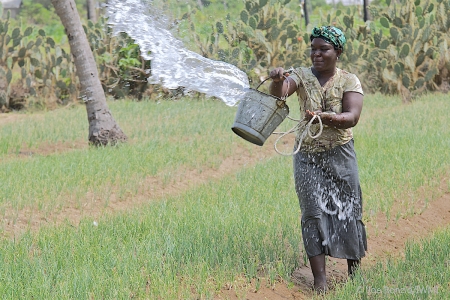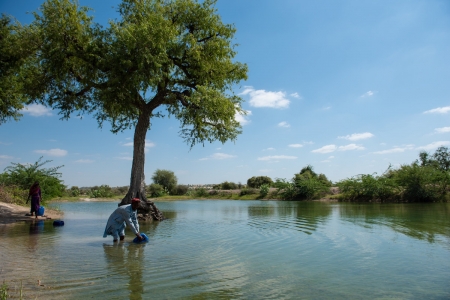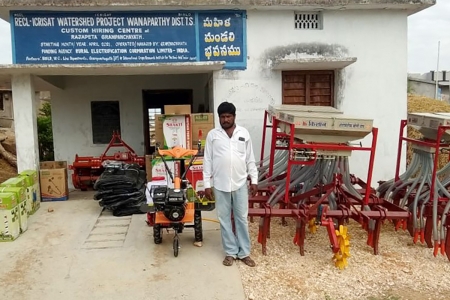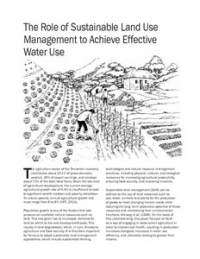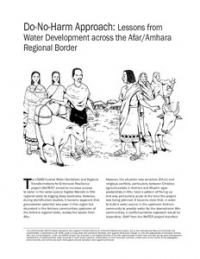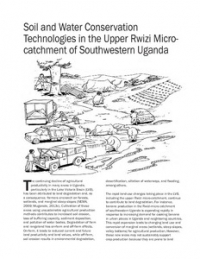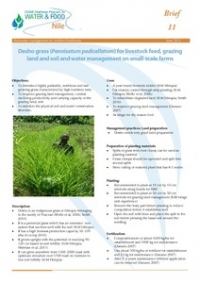Water is essential for all of Earth's ecosystems and the food systems they support. However, as climate change becomes more pronounced, water resources are coming under increasing strain. Higher temperatures, shifting weather patterns and less predictable rainfall are leading to deteriorating water quality, less reliable water availability and rising water scarcity.
As the biggest user of freshwater – responsible for 70% of global freshwater withdrawals – agriculture is uniquely and increasingly exposed to these climate-induced risks. If farming is to mitigate and adapt to climate change, it must adopt sustainable, climate-smart agricultural water management (AWM) practices and technologies.
To explore the potential of AWM for climate resilience, WLE has teamed up with the CGIAR Research Program on Climate Change, Agriculture and Food Security (CCAFS) to host an hour-long session at COP26, the United Nation's Climate Change Conference in Glasgow. On Tuesday, November 9, 'Water and Climate-Smart Agriculture for Adaptation' will focus on the ways AWM can improve water sustainability, increase land and water use efficiency, boost yields and even reduce emissions through better water management and lower energy and fertilizer use.
Prioritizing AWM interventions
Given the broad range of AWM practices and technologies to choose from, selecting AWM interventions that are context and situation specific is essential. The session will therefore showcase two complementary methods of choosing appropriate and effective AWM interventions. The first is a stakeholder participatory approach. This provides a framework for local stakeholders to identify location-specific practices based on implementation feasibility, acceptability, adoption barriers, synergy with government plans and schemes, incentive mechanisms and key institutions required.
By integrating local knowledge and experiences, the stakeholder participatory approach provides valuable information for the plan and design of AWM interventions. This was the case in Beed, a district of the Indian state of Maharashtra, where a participatory approach enabled local stakeholders to identify nine 'water-smart' technologies and practices, including irrigation scheduling and raised bed planting for vegetables, which were not only suitable for the local conditions, but could build water resilience and reduce the negative impacts of climate change on crop production.
One disadvantage of the stakeholder participatory approach is that it does not provide quantitative information about the impact AWM interventions may have on a region's water balance. To ensure that AWM practices do not inadvertently reduce water availability, the COP26 event will also demonstrate a second method of prioritizing AWM interventions – a simple water balance tool. This spreadsheet-based tool simulates the effects of AWM practices on an area's water balance, allowing implementing organizations to assess an intervention's impact on agricultural productivity, resilience and mitigation, using climate-smart metrics, such as yield, emissions and economic benefits.
Convergence and co-financing
As important as the prioritization of AWM practices and technologies is the ability to scale these interventions. WLE and CCAFS's COP26 event will demonstrate how intersectoral collaboration between institutions can produce the funds necessary to co-finance scaling. This kind of collaboration, known as convergence, brings together human and financial resources from different programs, schemes and institutions with a shared interest in a particular topic – in this case, climate-resilient water management.
In India's Beed district, for example, the nine water-smart solutions identified by local stakeholders were each aligned with existing or planned government schemes addressing similar challenges in the region. This allowed project actors to identify potential government support and funding for the implementation of AWM technologies and practices. In this way, convergence and co-financing opportunities offer a practical, achievable blueprint for the effective implementation of climate-smart AWM strategies within existing institutional systems.
The session will also explore the crucial role that water must play in climate mitigation and adaptation in Africa, where increasingly extreme and erratic weather patterns are predicted to bring short, irregular rainy seasons and frequent droughts to large stretches of the continent. Here, improving climate resilience will require social and technical innovations to accelerate investment and collective action in water solutions, such as small-scale irrigation. The session will investigate how the Great Green Wall initiative, which aims to plant millions of trees across the continent's vulnerable Sahel region, can support inclusive small-scale irrigation and climate adaptation for farmers.
A call to action at COP26
The adverse impacts of climate change on water security are becoming increasingly urgent, especially for agriculture-dependent developing economies in the Global South. In keeping with this urgency, WLE and CCAFS's COP26 event will deliver several calls to action to attendees, including:
- Given the limited scope to improve the supply of water resources, more attention and effort should be focused on demand-side AWM interventions, such as solar irrigation
- Climate-smart AWM interventions need to be prioritized to ensure they are location specific and socially relevant
- The stakeholder participatory approach and the water balance tool should be used together to prioritize AWM interventions and make better investment decisions
- Interventions must be systematically responsive and adaptive – there is no silver bullet for climate-smart agriculture
- Convergence and co-financing of resources is a must for meaningful investment in, and scaling of, AWM solutions.
'Water and Climate-Smart Agriculture for Adaptation' will take place 10:15-11:15 GMT on Tuesday, 9 November. For more information, and to watch the live stream, click here.

